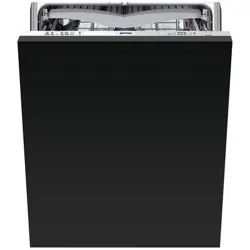Documents: Go to download!
User Manual
- User Manual - (English)
- Smeg DWAFI6314 Fully Integrated DishDrawer Specifications Sheet - (English)
- Description of the controls
- Operating instructions
- Cleaning and maintenance
- Troubleshooting
Table of contents
User ManualSmeg DWAFI6314 Dishwasher
Description of the controls
Upper panel
All the dishwasher controls are grouped on the upper panel. Switch-on,
programming, switch-off, etc. procedures are only possible when the door is
open. 
The panel shown is only a guideline example: the form of the lights and buttons may vary depending on the model.
- ON/OFF BUTTON
Press this button to switch the dishwasher on/off. - SELECTED PROGRAM INDICATOR LIGHTS
Illumination of this light denotes the program selected and the occurrence of a fault (troubleshooting). - PROGRAM SELECTION BUTTON
 + ADJUSTING THE WATER SOFTENING SYSTEM
+ ADJUSTING THE WATER SOFTENING SYSTEM
Used to select the washing program required and adjust the water softening system. - RINSE AID WARNING LIGHT
Illumination of this light denotes a rinse aid warning level in the tank. - QUICK TIME OPTION BUTTON
The button controls selection of the quick time programs. (see table). - QUICK TIME OPTION LIGHT
Illuminates to indicate that one of the quick time programs (see table) is going to be executed. - PROGRAM DELAY BUTTON
Press this button to delay the start of the program. - DELAYED START LIGHTS
Illuminate to show that start delayed by 3, 6 or 9 hours has been set.
SETTING THE WASHING PROGRAM AND SWITCHING ON
After identifying the most suitable program with the aid of the programs table:
- Press the ON/OFF button (1) and wait for the PROGRAM INDICATOR LIGHT (2) to illuminate;
- Keep pressing the PROGRAM SELECTION button (3) until the indicator light corresponding to the desired program illuminates;
- select the option required (if any and if the model provides options);
- close the door; after about 2" the program will start LIGHT will flashing (indicating that the program is being executed).

PROGRAMS TABLE

The ULTRA CLEAN program terminate with an extra anti-bacteria rinse that ensures a further reduction in the bacteria level. If the temperature falls during this stage of the program (e.g. because the door is opened or due to a power blackout), the program lights (2) flash to warn that the anti-bacteria effect is not guaranteed.
* Reference program as per AS/NZS 2007.
During the comparative tests the dishwasher shall to be setted as follow:
- At the end of the cycle the door must be opened about 15 cm.
Only run the soak program with partial loads.
(1) The cycle duration and power consumption may vary according to the water and room temperatures, and the type and amount of dishes.
 If the dishwasher door is open or not properly closed, the washing cycle will not start.
If the dishwasher door is open or not properly closed, the washing cycle will not start.
QUICK TIME PROGRAMS
(see relevant section for explanation of functioning modes)
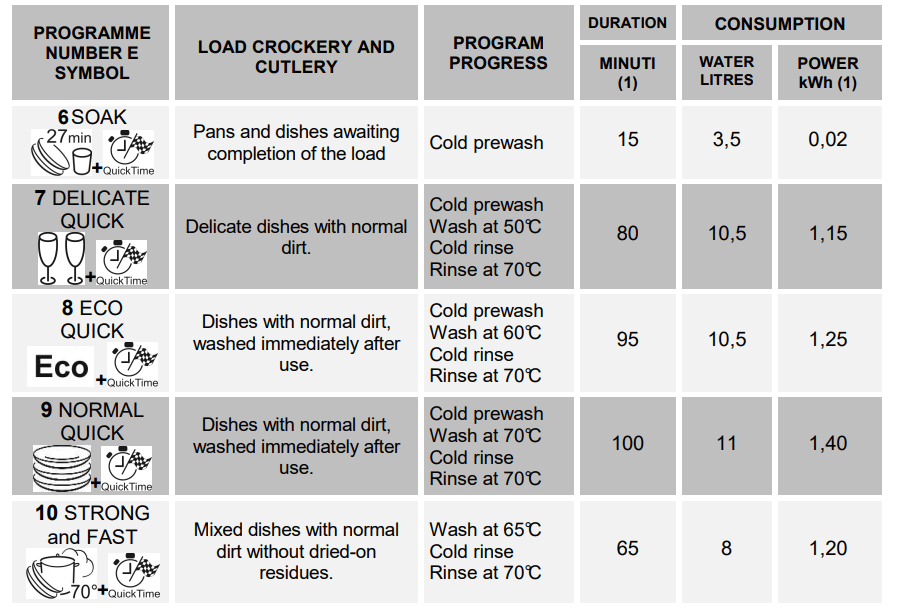
IMPORTANT: see “NOTES AND REFERENCES” table on the following pages.
Washing programs
Before starting a washing program make sure that:


- The water supply tap is open.
- The correct amount of detergent has been added to the dispenser.
- The baskets have been correctly loaded.
- The spray arms are able to rotate freely and without obstruction.
- The dishwasher door is securely closed.

QUICK TIME OPTION

Select this option to SHORTEN the cycle. To activate this option, press button (light comes on) after selecting the program required.
The option is automatically deactivated at the end of the program.
PROGRAM DELAY

The start of the program can be delayed by 3, 6 or 9 hours.
This allows you to set the dishwasher to work at the times of day most convenient to you. After setting the program, press the button to select the delay you require; the corresponding light will come on. When the door is closed, the appliance will prewash the dishes, after which the "program delay" set will come into effect. If you wish to exit the procedure without setting delayed start, press the button in sequence until all three lights are out.
N.B.: It is not possible to select the PROGRAM DELAY option once the cycle has begun.
CANCELLING THE CURRENT PROGRAM
- To cancel the currently selected program open the door and hold down the PROGRAM SELECTION (3) button for a few seconds until the indicator lights for programs 4 and 5 illuminate simultaneously (marked "end").

- Close the door.
- After approximately 1 minute the dishwasher will advance to the end of cycle

CHANGING THE PROGRAM
To change the program in progress, simply open the door and select a new program. When the door is closed the dishwasher will automatically select the new program.
TO SAVE ON ENERGY! … AND PROTECT THE ENVIRONMENT
- Always use the dishwasher with a full load.
- Do not wash the dishes in running water.
- Use the washing program that is most appropriate for each type of load.
- Do not carry out any preliminary rinsing.
- If available, connect the dishwasher to a hot water supply up to 60°C.
TO CUT DOWN ON DETERGENT CONSUMPTION! … AND PROTECT THE ENVIRONMENT
The phosphates contained in dishwasher detergents are harmful to the environment. To avoid using excessive amounts of detergent and to save on electricity, observe the following:
- separate the more delicate items from dishes that are more resistant to aggressive detergents and high temperatures;
- do not pour the detergent directly on the dishes.
If the door has to be opened while washing is in progress, the program will be interrupted. The relative light will keep flashing and a beeper will signal that the cycle has not been completed. You must wait about 1 minute before closing the door to restart the program. When the door is closed the program will continue from where it was interrupted. This operation should only be carried out if strictly necessary, because it might cause problems in execution of the program.
- SWITCHING OFF
At the end of the program the beeper sounds briefly and the lights of programs no. 4 and 5 (marked "end") flash.
4 and 5 (marked "end") flash.
To switch off the dishwasher, open the door and press the ON/OFF button (1).
ENERGY MANAGEMENT
After 5 minutes of waiting (washing cycle completed, stopped or set but not started) the dishwasher switches to a standby state to reduce energy consumption. In this state, the dishwasher indicator panel (lights or display depending on model) functions more slowly (switch-on once every 5 seconds).
REMOVING THE DISHES
At the end of the washing program, wait at least 20 minutes before removing the dishes, to allow them to cool. To ensure that any drops of water left in the top basket cannot drip onto the dishes still in the bottom basket, you are advised always to empty the bottom basket first.
Operating instructions
Once the dishwasher has been correctly installed, prepare for use as follows:
- Add the rinse aid and detergent
Using the rinse aid and detergent dispensers
The detergent and rinse aid dispensers are situated on the inner part of the door: the detergent dispenser is on the left, and the rinse aid dispenser is on the right.
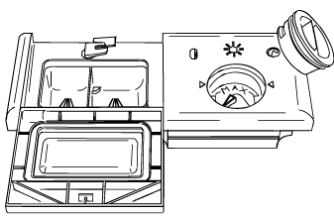
 ADDING THE RINSE AID
ADDING THE RINSE AID
The rinse aid helps the dishes dry faster and prevents the formation of scale deposits and staining; it is automatically added to the water during the final rinse cycle, from the container situated on the inner side of the door.

To add rinse aid:
- Open the door.
- Rotate the container cap anticlockwise by ¼ of a turn and remove it.
- Add the rinse aid until the container is full (approximately 140 cc). The optical level indicator on the side of the cap should be completely obscured. Refill the rinse aid when the optical level indicator becomes clear again, or when the rinse aid warning light illuminates.
- Replace the cover and turn it in a clockwise direction.
- Use a cloth to remove any spillage of rinse aid which might lead to the formation of excess foam.
ADJUSTING THE RINSE AID DISPENSER SETTING
The dishwasher is factory set for medium water hardness. However it possible to change the setting by turning the dispenser’s selector to the desired position: the amount of rinse aid dispensed is proportional to the selector position.
- To adjust the rinse aid setting, rotate the dispenser cap through a quarter turn in an anticlockwise direction and remove it.
- Then use a screwdriver to rotate the rinse aid selector to the desired position.
- Replace the cap, turning it clockwise.
ADDING THE DETERGENT
To open the detergent dispenser cap, lightly press the button P. Add the detergent and close the cap carefully.

During the washing cycle, the dispenser will be opened automatically.
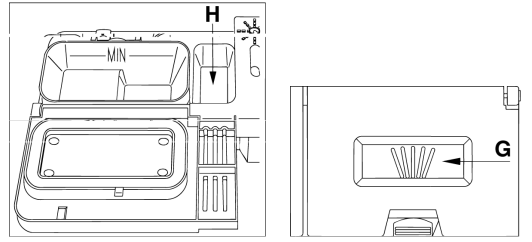
- When a program with hot prewash is selected (see program table), extra detergent must be placed in the cavity G/H (depending on models).
- Use only detergents specially formulated for dishwashers. For optimal washing results it is important to use a good quality detergent.
- The detergent packs must be sealed and stored in a dry place to prevent the formation of lumps which may negatively affect washing results. Once opened the detergent packs should not be kept for too long, otherwise the detergent loses its effectiveness.
- Do not use detergents formulated for washing dishes by hand, because they produce a great deal of foam and may negatively affect the operation of the dishwasher.
- Add the correct amount of detergent. An insufficient amount of detergent will result in a partial removal of dirt from the dishes, whereas an excessive amount is wasteful and does not improve the washing results.
- The market offers liquid and powder detergents with differing chemical compositions, which may contain phosphates, or be phosphate-free but contain natural enzymes.
- Detergents containing phosphates are more effective against grease and starch at temperatures above 60°C .
- Enzyme detergents, on the other hand, are also effective at lower temperatures (from 40 to 55°C ) and are more easily biodegradable. With enzyme detergents it is possible to obtain at low temperatures comparable results to those which can only be achieved at 65°C using traditional detergents.
For the safeguarding of the environment we recommend the use of phosphate- and chlorine free detergents.
General warnings and recommendations
Before using the dishwasher for the first time, it is advisable to read the following recommendations concerning dish types to be washed and their loading. There are generally no constraints on the washing of domestic dishes, but in certain cases it is necessary to take their characteristics into account.
Before loading the dishes into the baskets it is necessary to:
- remove coarse food remains: e.g. bones, fish-bones, etc. which may clog the filter or damage the wash pump.
- soak any pots or pans with burnt-on food remains on the bottom to facilitate removal, then load them into the LOWER BASKET.
There is no need to pre-wash the dishes under running water before loading them into the baskets since this only wastes water.
Correct loading of the dishes helps ensure optimal washing results.
MAKE SURE that the items being washed are dishwasher-safe.
Items which are not dishwasher-safe:
- Wooden dishes, pots or pans: these may be damaged by the high washing temperatures.
- Handcrafted items: these are rarely suitable for washing in a dishwasher. The relatively high water temperatures and the detergents used may damage them.
- Plastic dishes: heat resistant plastic dishes must be washed in the upper basket.
- Dishes and objects in copper, tin, zinc or brass: these tend to stain.
- Aluminium dishes: items made from anodised aluminium may lose their colour.
- Silverware: silver items may stain.
- Glass and crystal: in general, glass and crystal objects can be washed in the dishwasher. However, certain types of glass and crystal may become dull and lose their clearness after many washings. Therefore, for these items we recommend using the least aggressive program available.
- Decorated items: the decorated objects available on the market are generally able to withstand washing in the dishwasher, although the colours may fade after a great many washes. If in doubt as to the fastness of the colours, it is advisable to wash just a few items at a time for approximately one month.
Using the baskets
The dishwasher has a capacity of 15 place-settings, including serving dishes.
LOWER BASKET
The lower basket receives the full force of the lower spray arm, and should therefore be used for the “toughest” items with a heavier degree of soiling.
All types and combinations of loads are permitted, provided that the dishes, pots and pans are arranged with all the soiled surfaces exposed to the water jets coming from the bottom.
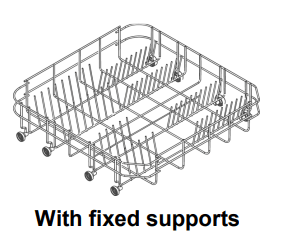
To make the most of the space inside the basket when loading large items, certain models are equipped with tip-up supports for plates in 2 or 4 sections.
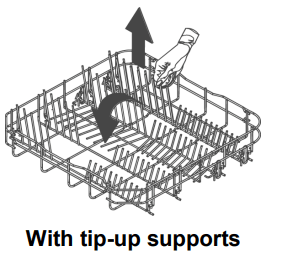
BOTTOM BASKET INSERTS
Some models are equipped with bottom basket inserts which improve the drying of dishes. The inserts are supplied in the accessories bag; to use them, simply fit them into place as shown.
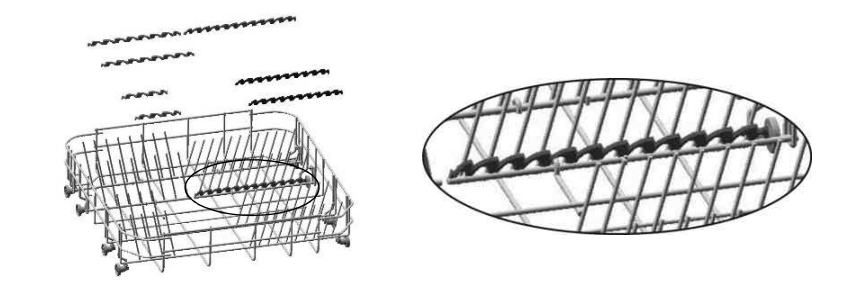
LOADING THE LOWER BASKET
Carefully load flat plates, soup plates, dessert and serving dishes, positioning them vertically. Pots, pans and their covers must be loaded upside down. When loading soup plates and dessert bowls, be sure to leave a gap between them.
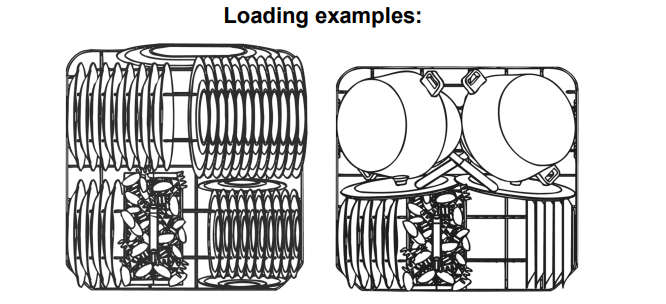
CUTLERY BASKET
The basket has removable top grids into which items of cutlery should be inserted to keep them properly spaced and allow water to pass between them effectively. The top grids and central lid are in the bag of accessories. The central lid functions as a lid only. The top grids can be detached and used separately. The cutlery should be arranged in an orderly manner inside the basket, with the handles pointing downwards. Take care during loading to avoid injury from the knife blades. The basket is suitable for all types of cutlery, except those long enough to interfere with the upper spray arm. Ladles, wooden spoons and cooking knives can be placed in the upper basket, making sure that the knife blades do not protrude from the basket.

The cutlery basket slides across the dishwasher and can be placed in any position to allow optimal use of the space in the bottom basket.

TOP CUTLERY BASKET
The basket is designed to take cutlery, placed in the spaces provided, and long utensils, positioned lengthwise. The “drawer” extraction system makes the basket easier to load, but it can also be taken completely off its runners by removing the retainers (as shown here). Take great care to replace the retainers to ensure that the basket does not come off the runners accidentally.
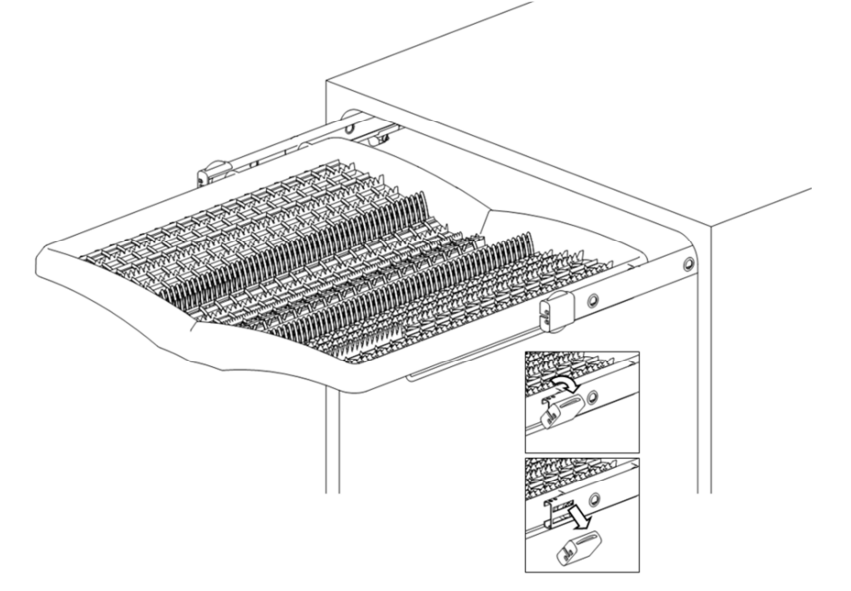
UPPER BASKET
It is recommended to load the upper basket with small- or medium-sized items such as glasses, small plates, tea or coffee cups, shallow bowls and light objects made from heat resistant plastic. If the upper basket is used in the lowermost position, it can also be loaded with serving dishes, provided they are only slightly soiled.
LOADING THE UPPER BASKET
Load plates facing forward; cups, bowls etc. must always be facing downwards. The left side of the basket can be loaded with cups and glasses on two levels. In the centre section, plates and saucers can be loaded vertically into the supports provided.
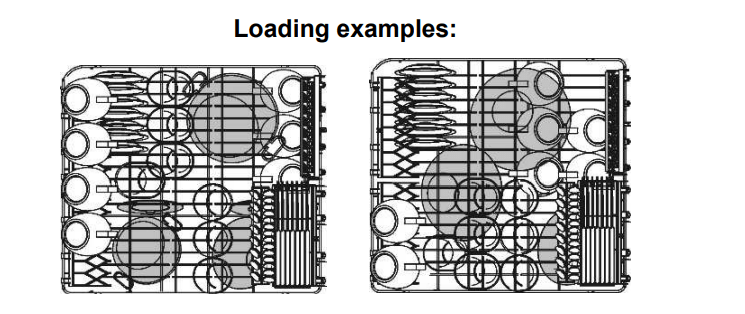
Depending on the models, the basket may be equipped with some or all of the following accessories:
- Supports for cups or long objects (ladles, spoons…), on the left; can be tipped to the vertical position when not in use.
- Long-stemmed glass holder, on the left; to use, simply lift and fix onto the hooks provided.
- Cutlery racks, on the right, designed for knives and teaspoons; for teaspoons, pull out the sliding support. The racks can be tipped to the vertical position when not in use.
- Fixed or movable racks in the middle. The movable supports can be fixed vertical, resting on the bottom of the basket when not in use, or set in the intermediate position, as required.

ADJUSTING THE UPPER BASKET
The height of the top basket can be adjusted to allow large dishes or pans to be placed in the bottom basket.
The adjustment procedure may be type A or B, depending on the dishwasher model purchased.
Version A: pull-out with adjustment in two positions.
- Pull out both the basket guides.
- Remove the stops, first releasing them as shown in the diagram.
- Pull out the basket.
- Fit the upper or lower pair of wheels into the guide, depending on the setting required;
- Return the stops to their original position.
The left hand and right hand sides of the basket must always be set at the same height.

Version B: with adjustment in three positions on both sides.
The sides of the basket must always be set at the same height.
- Raise the basket by pulling on the top edge (1), to the first or second catch depending on the height required.
- To lower the basket, first release it by pulling the release lever (2).
Adjustment is also possible with the basket loaded, but in this case when lowering the basket it should be held steady with one hand to avoid knocking the dishes.
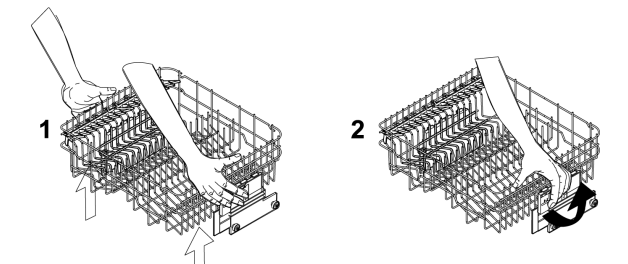
Cleaning and maintenance
Before carrying out any work, always unplug the appliance from the electrical supply or switch off the all-pole disconnection device.
General warnings and recommendations
Avoid the use of acidic or abrasive detergents.
Clean the outer surfaces and door-lining of the dishwasher regularly using a soft cloth moistened with water or with a normal detergent suitable for painted surfaces. Clean the door gaskets with a damp sponge. Periodically (once or twice a year) it is advisable to clean the tank and gaskets, using a soft cloth and water to remove any deposits.
CLEANING THE WATER INTAKE FILTER
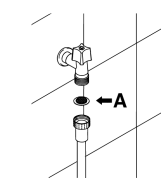
The water intake filter A located at the outlet of the water supply tap needs to be cleaned periodically.
After having closed the water supply tap, unscrew the end of the water intake hose, remove the filter A and clean it delicately under running water. Reassemble filter A in its seat and carefully screw the water intake hose back into position.
CLEANING THE SPRAY ARMS
The spray arms can be easily removed for periodic cleaning of the nozzles, to prevent possible clogging. Wash them under running water and carefully replace them in their seats, checking that their rotary movement is in no way impeded.
- To remove the upper spray arm, unscrew locking ring R.
- To remove the lower spray arm, simply lift it up, pulling by the central part.
- To remove the orbital spray arm assembly, take hold of the longer arm and pull the orbital unit upward. Wash the arms under a jet of running water and return them carefully to their seat. After reassembly, check that the spray arms turn freely. Otherwise, check that they have been installed correctly.

CLEANING THE FILTER UNIT
- It is advisable to periodically inspect the centre filter C and, if necessary, to clean it. To remove the filter, grip the tabs, turn them anticlockwise and lift upwards;
- push the centre filter D from the underside to remove it from the micro-filter:
- separate the two parts which make up the plastic filter by pressing the body of the filter in the zone shown by the arrows;
- remove the centre filter by lifting it upwards.

BEFORE STARTING THE DISHWASHER AFTER PROLONGED DISUSE:
- Check that there are no deposits of sludge or rust inside the water pipe: if there are, allow the water to run from the water supply tap for a few minutes.
- Plug the power cord back into the socket.
- Reconnect the water intake hose and open the tap again.
TROUBLESHOOTING MINOR PROBLEMS
In some cases it is possible to remedy minor problems by referring to the following instructions:
If the program fails to start, check that:
- the dishwasher is connected to the electrical power supply;
- there is no power failure;
- the water tap is open;
- the dishwasher door is properly closed.
If water remains inside the dishwasher, check that:
- the drain hose is not kinked;
- the drain siphon is not obstructed;
- the dishwasher filters are not clogged.
If the dishes are not being cleaned properly, check that:
- the correct amount of detergent has been added;
- the dishes are being loaded correctly;
- the selected program is suitable for the dish types and their degree of soiling;
- all the filters are clean and positioned correctly;
- the spray arm nozzles are not obstructed;
- there is no object obstructing the rotation of the spray arms.
If the dishes fail to dry or remain dull, check that:
- there is rinse aid inside the special container;
- the rinse aid dispenser setting is correct;
- the detergent used is of good quality and has not lost its effectiveness (for example, through incorrect storage, with the box left open).
If the dishes show signs of streaking, staining, etc., check that:
- the rinse aid dispenser setting is not too high.
If there are visible traces of rust inside the tank:
- the tank is made of steel, and therefore any rust marks are due to external elements (fragments of rust from the water pipes, pots, cutlery, etc.). Special products are commercially available to remove such marks;
- check that the amount of detergent being used is correct. Certain detergents can be more corrosive than others.
Troubleshooting
The dishwasher is capable of signalling a number of faults through the simultaneous illumination of several indicator lights, with the following meanings:
FAULT | DESCRIPTION | |
| E1 |  | Acquastop failure The anti-flooding system has been activated (for the relevant models only). The system is tripped in case of water leaks. Contact the after-sales service. |
| E2 |  | Safety level The system which limits the water level inside the dishwasher has been tripped. Interrupt the program and switch off the dishwasher. Switch the dishwasher back on, program it again and start the washing cycle. If the problem persists, contact the after-sales service. |
| E3 |  | Water heating malfunction The water is not heated or the heating parameters are not correct. Repeat the washing program; if the problem persists, contact the after-sales service. |
| E4 |  | Water temperature monitoring malfunction Interrupt the program and switch off the dishwasher. Switch the dishwasher back on, program it again and start the washing cycle. If the problem persists, contact the after-sales service. |
| E5 |  | Water intake malfunction The appliance does not take in water or does not do so correctly. Check that the water connections are correct, the water intake tap is turned on and the filter is not fouled. If the problem persists, contact the after-sales service. |
| E6 |  | Water pump-out malfunction The appliance does not pump out the water or does not do so correctly. Check that the drain hose is not kinked or crushed and that the siphon and filter are not fouled. If the problem persists, contact the after- sales service. |
| E7 |  | Turbine flow-regulator malfunction (for the relevant models only) The appliance is not able to "measure" the amount of water loaded accurately. Interrupt the program and switch off the dishwasher. Switch the dishwasher back on, program it again and start the washing cycle. If the problem persists, contact the after-sales service. |
| E8 |  | Alternate washing system malfunction Interrupt the program and switch off the dishwasher. Switch the dishwasher back on, program it again and start the washing cycle. If the problem persists, contact the after-sales service. |
| E9 |  | Water intake system malfunction Contact the after-sales service. |
 Light off
Light off  Light on
Light on  Light flashing
Light flashing
If an alarm occurs the appliance interrupts the program in progress and signals a fault.
- Alarms E1, E2, E3, E4, E8 and E9 interrupt the current program immediately.
- The E5, E6 alarms interrupts the running program once the cause is resolved, it will bring bach the execution of the program.
- The alarm E7 is visualized at the end of the cycle that comes, however, brought to the end since the operation of the dishwasher is not harmed.
To “reset” an alarm is necessary:
- Open and close the door, or turn off and on the machine. At this point is possible to program the dishwasher again.
See other models: SD7220FND2P1 SMTC01 PV164B2 FA8003AOS FQ55FX2PE
